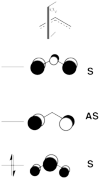Différences entre les versions de « VBTutorial2 »
Aller à la navigation
Aller à la recherche
VB applications on PI systems
| Ligne 10 : | Ligne 10 : | ||
| − | + | <center><big><big><big> '''VB applications on PI systems''' </big></big></big></center> | |
| − | + | ||
| + | |||
| + | = To the Tutors = | ||
'''[[Sason_remarks|Sason remarks and prospective 2 hours talk]]''' | '''[[Sason_remarks|Sason remarks and prospective 2 hours talk]]''' | ||
+ | + | ||
| Ligne 25 : | Ligne 27 : | ||
* Ozone : paper exercise ; expand MO wf in VB basis, wieghts of biradical with HF, compute with XMVB (VBSCF, BOVB) | * Ozone : paper exercise ; expand MO wf in VB basis, wieghts of biradical with HF, compute with XMVB (VBSCF, BOVB) | ||
* Benzyl radical with most spin alternant determinants (2 determinants) (p228 of The Book) show spin location. '''Objection : this uses Heisenberg spin hamiltonian theory, a topic that we do not teach.''' | * Benzyl radical with most spin alternant determinants (2 determinants) (p228 of The Book) show spin location. '''Objection : this uses Heisenberg spin hamiltonian theory, a topic that we do not teach.''' | ||
| − | |||
| − | (trash: * O2 paradigm : compute singlet - triplet gap : too hard) | + | (trash: * O2 paradigm : compute singlet - triplet gap : too hard |
| + | * H2O lone pairs : compute H2O+ states (2 configurations mixing) '''Objection : did you try to do that ? If we let the orbitals optimize themselves, I guess we will converge to the MO solution with weight 1.0, the other structure with weigt 0.0. The H2O+ states would better be done as qualitative exercises.''') | ||
| + | |||
| + | = Exercices = | ||
| − | == | + | == Exercice 1 (title) == |
| − | |||
=== Subject === | === Subject === | ||
Here is a image example [[File:Allyl_cation_MO.png|thumb|right| 100px|alt=Example alt text |Image example: Allyl Cation MO's]] | Here is a image example [[File:Allyl_cation_MO.png|thumb|right| 100px|alt=Example alt text |Image example: Allyl Cation MO's]] | ||
| Ligne 40 : | Ligne 43 : | ||
[[VBFile 2-2 | title]] | [[VBFile 2-2 | title]] | ||
| − | == | + | == Exercice 2 (title) == |
| − | == | + | == Exercice 3 (title) == |
Version du 25 mai 2012 à 08:31
How to modify this page :
- first : log in (top right of this page) ;
- click on [edit] (far right) to edit a section of the page ;
- write your text directly in the wiki page, and click on the "Save page" button (bottom left) to save your modifications
See also this page for an introduction to the basics of the wiki syntax
To the Tutors
Sason remarks and prospective 2 hours talk +
Philippe's remark on the initially proposed tutorial. are included in bold.
Qualitative
- Exercices from The Book ... >PCH< (30')
Computational
- Allyl cation : VB 3 configuration (3rd configuration has a large weight).
- Benzene : question about basis of covelent structures (paper exercise, then xmvb zith str=cov), then all ionics.
- Ozone : paper exercise ; expand MO wf in VB basis, wieghts of biradical with HF, compute with XMVB (VBSCF, BOVB)
- Benzyl radical with most spin alternant determinants (2 determinants) (p228 of The Book) show spin location. Objection : this uses Heisenberg spin hamiltonian theory, a topic that we do not teach.
(trash: * O2 paradigm : compute singlet - triplet gap : too hard
- H2O lone pairs : compute H2O+ states (2 configurations mixing) Objection : did you try to do that ? If we let the orbitals optimize themselves, I guess we will converge to the MO solution with weight 1.0, the other structure with weigt 0.0. The H2O+ states would better be done as qualitative exercises.)
Exercices
Exercice 1 (title)
Subject
Here is a image example
Th
